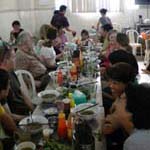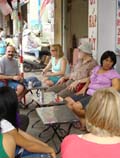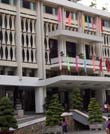click on an image for larger view
Saigon - yes, it's true that the city name is now Ho Chi Minh City, but it is still referred to as Saigon by most of its citizens. If you buy a T-shirt, you can bet that lettering will be “Saigon” and not “Ho Chi Minh City”. After all – that’s a lot of letters.
 With a population of over 5 millions people, it’s no wonder that Saigon is difficult to maneuver. Walking is a hazard because of the numerous scooters that congest the roadways. Scooters need not only avoid the chaotic paths of other drivers but also the pedestrians who walk the streets because the sidewalks are congested with vendors. With a population of over 5 millions people, it’s no wonder that Saigon is difficult to maneuver. Walking is a hazard because of the numerous scooters that congest the roadways. Scooters need not only avoid the chaotic paths of other drivers but also the pedestrians who walk the streets because the sidewalks are congested with vendors.
 On many streets, it is common to see houses with the ground floor converted into a business front while several families share living areas on the upper levels. Near curbing, hundreds of shielded wires are draped among frequently planted poles and then to buildings along the way. Frequently we could see workman climb bamboo ladders, apparently to fix, add or change cable. How they find the correct wire is beyond me. On many streets, it is common to see houses with the ground floor converted into a business front while several families share living areas on the upper levels. Near curbing, hundreds of shielded wires are draped among frequently planted poles and then to buildings along the way. Frequently we could see workman climb bamboo ladders, apparently to fix, add or change cable. How they find the correct wire is beyond me.
  Virtually every aspect of daily life is played out in the commotion of the streets. There is a potent mixture between the waves of scooters, the slower-paced cyclos (three-wheelers pedaled by a driver), bicycles and pedestrians. All too often, bikes are packed with merchandise piled far too high and wide for comfort – much less safety. Virtually every aspect of daily life is played out in the commotion of the streets. There is a potent mixture between the waves of scooters, the slower-paced cyclos (three-wheelers pedaled by a driver), bicycles and pedestrians. All too often, bikes are packed with merchandise piled far too high and wide for comfort – much less safety.
Most vehicles travel at relatively slow speeds, so accidents are few and tempers rarely flare when people brush or nudge each other. People are constantly treated to an arms length view of their fellow commuters. Conversations, even flirtations, are spontaneous, casual and common. The famously Confucian temperament of the Vietnamese gracefully lends itself to these phenomena. Even in the worst traffic jams, people remain calm, poised and always armed with a smile instead of a sneer when the smoggy, slow and crowded conditions become too much to handle.
Serene temples, fruits and vegitables, straw conical hats, hushed children sitting cross-legged in the streets while parents sell their wares - and - incredibly low prices. What’s not to like.
Family Hotel
  Because of the family of our friends Hiep and Xuan, we stayed in an area known as Binh Thanh. In this quiet neighborhood and tucked within the linked edifices of neighbors homes and shops is a small family run hotel. This newly built; five-story structure would be our home during our stay in Saigon. Because of the family of our friends Hiep and Xuan, we stayed in an area known as Binh Thanh. In this quiet neighborhood and tucked within the linked edifices of neighbors homes and shops is a small family run hotel. This newly built; five-story structure would be our home during our stay in Saigon.
   Not in view from any main corridor, the Tu Guynh Hotel is within what we might call an “alley” – an alley that follows a random path with forks that would make it difficult for any tourist to find the hotel. Even if you were lucky enough to choose the correct path, you might walk on by because there are no obvious clues to its presence. No signs, no flashy lights. Not in view from any main corridor, the Tu Guynh Hotel is within what we might call an “alley” – an alley that follows a random path with forks that would make it difficult for any tourist to find the hotel. Even if you were lucky enough to choose the correct path, you might walk on by because there are no obvious clues to its presence. No signs, no flashy lights.
 But –enter its lobby and the smiling faced family that owns and runs this wonderful property will greet you. The rooms are large and well equipped, the bathroom clean and new, and our room had a balcony that overlooked the neighborhood. All this for a whopping $10 per night. But –enter its lobby and the smiling faced family that owns and runs this wonderful property will greet you. The rooms are large and well equipped, the bathroom clean and new, and our room had a balcony that overlooked the neighborhood. All this for a whopping $10 per night.
The food
 No hamburgers within this neighborhood. No hamburgers within this neighborhood.  There is a good reason why even hardened eaters like Anthony Bourdain have fallen so in love with the cuisine of Vietnam. It's fresh, vibrant, varied, and satisfying without feeling gluttonously heavy. And, most often, it is cooked on the spot, right before your eyes, on the street, by someone who has been making that one particular dish over and over, for years, decades, quite possibly, generations. There is a good reason why even hardened eaters like Anthony Bourdain have fallen so in love with the cuisine of Vietnam. It's fresh, vibrant, varied, and satisfying without feeling gluttonously heavy. And, most often, it is cooked on the spot, right before your eyes, on the street, by someone who has been making that one particular dish over and over, for years, decades, quite possibly, generations.
Because we had experienced Saigon gastronomers amoung us, Xuan and Hiep were the obvious choices to introduce us to unknown eateries.
The market
The market is the perfect place where you can not only haggle for some nice local merchandise but also blend in with the locals and experience the real Vietnam. Here you can buy pretty much anything you ever wanted: prepared food, fruits, vegetables, candy, rice, jewelry, clothes and so on. As a tourist you might have to pay 50-100% more than the locals. But if you Xuan’s sister along or like to haggle, the skill will sure come in handy here.
Reunification Palace
  This building, currently a museum, used to be the official residence of the Presidents of the former South Vietnam. It was interesting to learn of its history but I could have done that on the Internet. I already know that this place is where President Diem was to occupy and after his assassination was the home of the president Nguyen Van Thieu and that it was here that the U.S. lost the war. So – seeing that these guys lived in a lot of luxury was no surprise. Not a highlight for me. This building, currently a museum, used to be the official residence of the Presidents of the former South Vietnam. It was interesting to learn of its history but I could have done that on the Internet. I already know that this place is where President Diem was to occupy and after his assassination was the home of the president Nguyen Van Thieu and that it was here that the U.S. lost the war. So – seeing that these guys lived in a lot of luxury was no surprise. Not a highlight for me.
War Museum
 The exhibit speaks for itself; it’s a rather distressing compendium of the horrors of modern warfare. Now called the War Remnants Museum - I think the place was originally called the American War Museum. But the new name is probably easier for foreigners (mostly Americans) to digest. Enter the building and it become obvious its intent. The war was horrible. Many of the atrocities documented here were well publicized in the West. Many pictures were familiar. The exhibit speaks for itself; it’s a rather distressing compendium of the horrors of modern warfare. Now called the War Remnants Museum - I think the place was originally called the American War Museum. But the new name is probably easier for foreigners (mostly Americans) to digest. Enter the building and it become obvious its intent. The war was horrible. Many of the atrocities documented here were well publicized in the West. Many pictures were familiar.
 Despite the relative one-sidedness of the exhibits, there are few museums in the world that drive home so well the point that war is brutal and that many of its victims are civilians. Even those who supported the war (which I did not) would have a difficult time not being horrified by the photos of children mangled by US bombing and na-palming. Not a highlight but important to see. Despite the relative one-sidedness of the exhibits, there are few museums in the world that drive home so well the point that war is brutal and that many of its victims are civilians. Even those who supported the war (which I did not) would have a difficult time not being horrified by the photos of children mangled by US bombing and na-palming. Not a highlight but important to see.
The city by scooter
 The best, and most fun, way to see Saigon is by scooter. Fortunately we had numerous young family members and friends more than willing to scoot us around town on the back of their motorized bikes. On the second night of our visit our convoy traversed alleys, streets and a ferry to visit parks and other points of interest while our primary goal was to find a great outdoor bar to share a beer (or many more). The best, and most fun, way to see Saigon is by scooter. Fortunately we had numerous young family members and friends more than willing to scoot us around town on the back of their motorized bikes. On the second night of our visit our convoy traversed alleys, streets and a ferry to visit parks and other points of interest while our primary goal was to find a great outdoor bar to share a beer (or many more).
 Here we gathered around long tables along a streets curb to share some Vietnamese cuisine and beverages while learning some important local gestures and words used to express camaraderie among friends. The more we consumed, the better we got at expressing these cheers – at least that is what I think I remember. Here we gathered around long tables along a streets curb to share some Vietnamese cuisine and beverages while learning some important local gestures and words used to express camaraderie among friends. The more we consumed, the better we got at expressing these cheers – at least that is what I think I remember.
  It was then time to return to our hotel. My driver, a wonderful young man who I later learned rarely drinks at all, suggested (by gesture) that it might be better if I be the driver. So – not having ever been on a scoot before – I drove - - with one goal in mind. Just don’t loose track of the vehicle in front of me and hope he knows where he is going and knows how to get there. We did! (get there – that is). It was then time to return to our hotel. My driver, a wonderful young man who I later learned rarely drinks at all, suggested (by gesture) that it might be better if I be the driver. So – not having ever been on a scoot before – I drove - - with one goal in mind. Just don’t loose track of the vehicle in front of me and hope he knows where he is going and knows how to get there. We did! (get there – that is).
|
